
Columnea is a genus of ca. 200 species of epiphytic herbs and shrubs in the flowering plant family Gesneriaceae, native to tropical America and the Caribbean. The tubular or oddly shaped flowers are usually large and brightly colored – usually red, yellow, or orange – sometimes resembling a fish in shape. A common name is flying goldfish plants due to the unusual flower shape.

Kohleria is a New World genus of the flowering plant family Gesneriaceae. The plants are generally tropical herbs or subshrubs with velvety stems and foliage and brightly colored flowers with spots or markings in contrasting colors. They are rhizomatous and commonly include a period of dormancy in their growth cycle. The genus was revised in 1992 and was then recognized as having 19 species distributed in Central America and South America. phylogenetic in 2005 indicated that the epiphytic genus Capanea is derived from within Kohleria, and the two species of Capanea were subsequently transferred to Kohleria. The genus Pearcea is closely related.
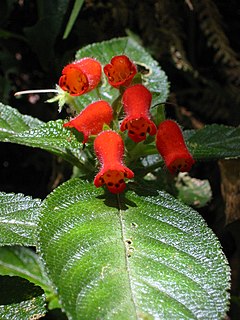
Pearcea is a genus of tropical herbaceous plants in the family Gesneriaceae native to western South America. It is classified in tribe Gloxinieae and is closely related to the genus Kohleria, in which some of its species were previously included. The genus Parakohleria has recently been synonymized under Pearcea, a conclusion later supported by molecular analyses that showed that Pearcea hypocyrtiflora was nested within the former Parakohlerias.
Glossoloma herthae is a plant species in the family Gesneriaceae. A recent review has moved it out of the genus Alloplectus.
Glossoloma martinianum is a plant species in the family Gesneriaceae. A recent review has moved it out of the genus Alloplectus.
Glossoloma penduliflorum is a plant species in the family Gesneriaceae. A recent review has moved it out of the genus Alloplectus.

Reldia is a genus of plants in the family Gesneriaceae. They are also in the Beslerieae tribe.
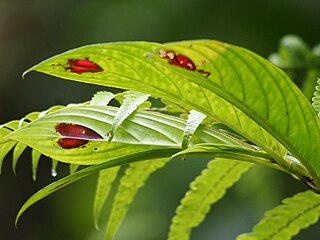
Columnea consanguinea is a species of flowering plants in the genus Columnea. They are endemic to Colombia, Costa Rica, Ecuador, Nicaragua, and Panama. They are distinctive for possessing red translucent heart-shaped markings on their leaves that serve to attract their main pollinators - the hummingbird Heliodoxa jacula - to their more inconspicuous flowers.

Crantzia is a plant genus in the family Gesneriaceae. Crantzia species grow in damp or wet forests, mostly on Caribbean islands. Some are epiphytes, others are subshrubs or herbaceous plants with fibrous roots.
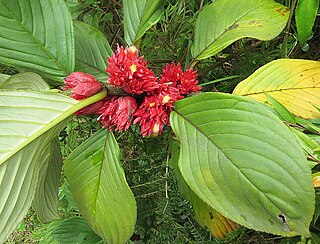
Glossoloma is a genus of Neotropical plants in the family Gesneriaceae. The species in the genus were formerly placed in Alloplectus. They are subshrubs with the leaves clustered at the ends of branches, and tubular flowers.
Fieldia australiana is a species of flowering plant in the family Gesneriaceae. It is a small tree from eastern Australian rainforests. It has also been placed as the sole species in the monotypic genus Lenbrassia.
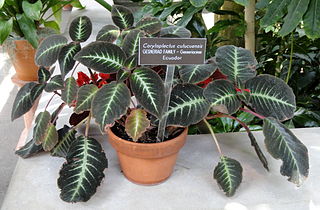
Corytoplectus is a genus in the plant family Gesneriaceae. Plants from Corytoplectus are found in Bolivia, Brazil North, Colombia, Ecuador, Guyana, Mexico Southwest, Peru, Venezuela, in the cloud-forests of the high cordillera. The genus contains c. 12 species. The genus differs from the closely related Alloplectus in having an erect umbellate inflorescence and berries. The type species is C. capitatus.
Amalophyllon is a genus of flowering plants belonging to the family Gesneriaceae.
Anetanthus is a genus of flowering plants belonging to the family Gesneriaceae.
Cremosperma is a genus of flowering plants belonging to the family Gesneriaceae.
Cremospermopsis is a genus of flowering plants belonging to the family Gesneriaceae.
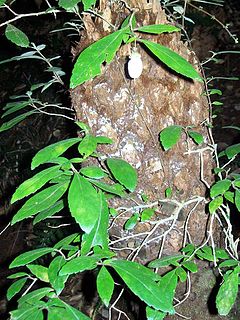
Fieldia is a genus of flowering plants in the family Gesneriaceae, native to New South Wales, Queensland and Victoria in Australia. It has at times been treated as monotypic, with one species, F. australis. Two are accepted as of April 2021 by sources that include Lenbrassia in Fieldia.
Cobananthus is a genus of flowering plants in the family Gesneriaceae, with a single species Cobananthus calochlamys. It is sometimes included in the genus Alloplectus, but molecular phylogenetic studies suggest that the two genera are not closely related, with Cobananthus more closely related to Alsobia.
Rufodorsia is a genus of epiphytic flowering plants in the family Gesneriaceae. The genus name refers to the reddish back of the upper lobes of the flower. The relationship of Rufodorsia with the genus Oerstedina is uncertain, as of April 2021. It is native to montane cloud forest in Central America.
Oerstedina is a genus of epiphytic flowering plants in the family Gesneriaceae, native to Mexico, Costa Rica and Panama. The relationship of Oerstedina to the genus Rufodorsia is uncertain, as of April 2021.









